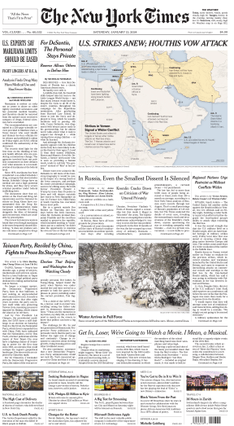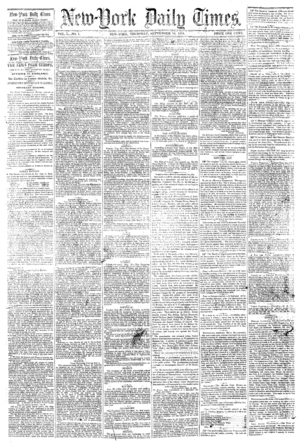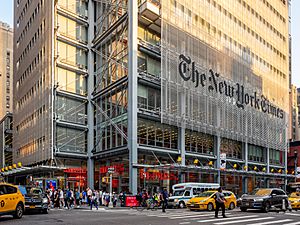The New York Times facts for kids
| All the News That's Fit to Print | |

The New York Times print edition
on January 13, 2024 |
|
| Type | Daily newspaper |
|---|---|
| Format | Broadsheet |
| Owner(s) | The New York Times Company |
| Founder(s) | |
| Publisher | A. G. Sulzberger |
| Founded | September 18, 1851 |
| Headquarters | 620 Eighth Avenue New York City, 10018, U.S. |
| Country | United States |
| Circulation | 11,880,000 news subscribers (as of August 2025) |
| Sister newspapers | International Herald Tribune (1967–2013) The New York Times International Edition (1943–1967; 2013–present) |
| ISSN | 0362-4331 (print) 1553-8095 (web) |
| OCLC number | 1645522 |
The New York Times (often called the NYT) is a famous American daily newspaper based in New York City. It covers news from the local area, the nation, and around the world. The paper also publishes opinion articles, special reports, and reviews. It is one of the oldest and most respected newspapers in the United States.
As of August 2025, The New York Times had more subscribers than any other newspaper in the country, with over 11 million people reading it online. The newspaper is published by The New York Times Company. Since 1896, the Ochs-Sulzberger family has been in charge of the company. The current publisher is A. G. Sulzberger.
The newspaper was started in 1851. It became well-known in the 1870s for its reporting on a corrupt politician named Boss Tweed. Over the years, the Times has covered many major world events. It won a famous Supreme Court case in 1971, New York Times Co. v. United States, which confirmed its right to publish the Pentagon Papers. These were secret government documents about the Vietnam War.
In 1996, the Times launched its website, nytimes.com, moving into the digital world. Today, it has journalists working on six continents. Besides the main newspaper, the company also produces The New York Times Magazine, podcasts like The Daily, and popular online games. The newspaper has won 132 Pulitzer Prizes, which are major awards for journalism.
History of The New York Times
Early Years (1851–1896)
The New York Times was founded in 1851 by two journalists, Henry Jarvis Raymond and George Jones. It quickly became popular, especially with readers who held conservative views. During the American Civil War, the newspaper sent reporters to the Confederate states to report directly from the war.
After Raymond's death, Jones took over. He used the paper to expose the corruption of a powerful New York politician, William M. Tweed. The Times published articles that showed how Tweed was misusing public money. This reporting led to Tweed's arrest and trial, and it earned the newspaper national respect.
A New Era (1896–1945)
In 1896, Adolph Ochs bought the newspaper and made big changes. He created the famous slogan, "All the News That's Fit to Print." Under Ochs, the Times focused on reporting about business and science. It was one of the first to report on Albert Einstein's theory of general relativity.
When Ochs died in 1935, his son-in-law, Arthur Hays Sulzberger, became the publisher. He led the paper through the Great Depression and World War II. During the war, the Times covered the conflict in great detail. It even had a journalist, William L. Laurence, who was chosen by the U.S. government to secretly document the Manhattan Project, the project that built the first atomic bomb.
Growth and Challenges (1945–1998)
After World War II, The New York Times continued to grow. In the 1960s, the paper was part of a landmark Supreme Court case, New York Times Co. v. Sullivan. The court's decision made it harder for public officials to sue the media for defamation (publishing false information that harms a reputation). This was a major victory for freedom of the press.
In 1971, the Times made history again by publishing the Pentagon Papers. These were secret government documents about the Vietnam War. The U.S. government tried to stop the newspaper, but the Supreme Court ruled that the Times had the right to publish them under the First Amendment.
The newspaper faced challenges as many readers moved to the suburbs. It responded by adding new sections to the paper, like "Home" and "Weekend," to attract more readers. In 1996, the Times launched its website, nytimes.com, marking its official entry into the digital age.
The Digital Age (1998–present)
The launch of nytimes.com was a turning point. The newspaper began to focus more on its online presence. It covered major events like the September 11 attacks with hundreds of reporters.
In 2011, the Times started charging for full access to its website. This "paywall" was a success. More people began paying for online news, especially after the 2016 United States presidential election.
Today, the newspaper is led by publisher A. G. Sulzberger. It continues to adapt to the changing media world by creating podcasts, videos, and online games. In 2022, it bought The Athletic, a popular sports news website.
How the Newspaper is Run
Leadership and Ownership
The New York Times is owned by The New York Times Company. The Ochs-Sulzberger family has controlled the company since 1896. This ensures that the newspaper can focus on long-term quality journalism instead of short-term profits. The current publisher is A. G. Sulzberger, who took over in 2018.
The company's chief executive is Meredith Kopit Levien. The newspaper's top editor is called the executive editor, a position held by Joseph Kahn since 2022. He leads a team of about 1,700 journalists.
Journalists and Bureaus
The New York Times has reporters based all over the world. These reporters work in offices called bureaus. There are bureaus in major U.S. cities like Washington, D.C., and Los Angeles, as well as in international cities like London, Beijing, and Mexico City.
Times journalists must follow strict ethical rules. For example, they are not allowed to support political candidates or causes publicly. This helps make sure their reporting is fair and unbiased.
The Editorial Board
The editorial board is a group of opinion writers who are separate from the news reporters. They write articles called editorials that represent the official views of the newspaper. The board often takes a stand on important issues and endorses candidates in elections.
For example, the board has supported laws for gun control and has written about climate change. Since 1960, it has endorsed the Democratic candidate in every presidential election. The editorial board is led by the opinion editor, Kathleen Kingsbury.
Content and Features
News and Newsletters
The main job of The New York Times is to report the news. But it also offers special newsletters. DealBook is a popular newsletter about business and finance. Another well-known project was FiveThirtyEight, a blog by Nate Silver that used data to predict elections.
In 2014, the Times launched The Upshot. This section uses data and graphics to explain complex topics in a simple way. During elections, The Upshot is famous for "the needle," a dial that shows the live probability of which candidate will win.
Crossword and Games
The Times crossword puzzle is one of the most famous in the world. It first appeared in 1942. Many people enjoy the challenge of solving it, especially the difficult Saturday puzzle.
In recent years, the newspaper has created more online games. These include Spelling Bee, Letter Boxed, and Connections. In 2022, the Times bought Wordle, a simple but very popular word game that became a global sensation. These games have attracted many new subscribers.
Cooking
The New York Times has a popular cooking section called NYT Cooking. It started as a website and app in 2014. It has thousands of recipes, cooking guides, and videos. Food editor Sam Sifton leads the section. Many home cooks rely on NYT Cooking for trusted recipes for everything from simple weeknight dinners to holiday feasts.
Style and Design
Writing Style
The New York Times has its own style guide that its writers must follow. One unique rule is the use of honorifics. This means the paper calls people Mr., Ms., Mrs., or Dr. on the second time they are mentioned in an article. For example, an article would say "Joe Biden" the first time, and "Mr. Biden" after that. The Times is one of the last major newspapers to do this, saying it is a "sign of civility."
The newspaper also has a strict policy on using offensive language. It usually avoids printing curse words, unless they are part of an important direct quote.
Headlines
At the Times, reporters do not write their own headlines. A special team of copy editors does that job. The goal is to create headlines that are accurate, interesting, and easy to understand. Print headlines have to fit in a small space, so they are often very short. Online headlines can be longer and are sometimes tested to see which one gets more clicks.
For very big news, the Times sometimes uses a "hammer headline." This is a huge, bold headline that takes up a lot of space on the front page. Examples include "BIDEN BEATS TRUMP" after the 2020 election and "TRUMP IMPEACHED."
Nameplate
The nameplate is the newspaper's name as it appears on the front page. The Times uses a fancy, old-style font called Blackletter. The design has been mostly the same for over 100 years. The most recent change was in 1967, when designer Ed Benguiat made small updates and, most famously, removed the period that used to be at the end of the name.
Other Publications
- The New York Times Magazine is a magazine that comes with the Sunday newspaper. It features long articles, photography, and the popular "The Ethicist" column.
- The New York Times International Edition is a version of the paper printed and sold around the world.
- The Times also had versions in Spanish (The New York Times en Español) and Chinese (纽约时报中文) to reach a global audience.
See also
 In Spanish: The New York Times para niños
In Spanish: The New York Times para niños



